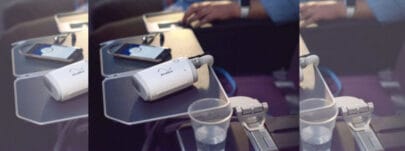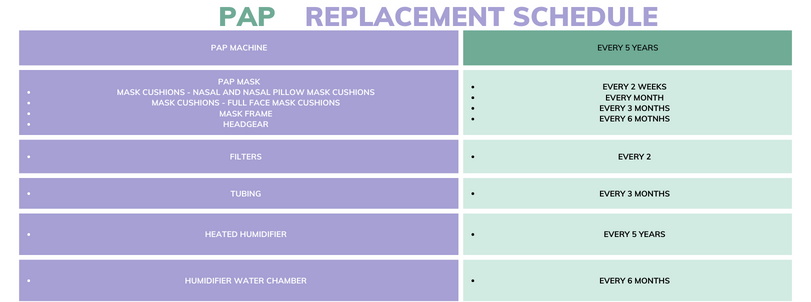
Why Following a PAP Replacement Schedule Is Crucial for Sleep Therapy
Managing the symptoms of obstructive sleep apnea (OSA) helps reduce the risk of health conditions such as heart disease and stroke linked to the disorder. For those prescribed PAP to treat sleep apnea, maintaining the required equipment and parts is crucial for effective treatment and obtaining the best results.
This includes keeping to a PAP replacement schedule covering the machine, mask, and associated parts.
Regular PAP replacement helps prevent air leaks from degraded materials, ensuring a continued effective treatment that eliminates your sleep apnea symptoms. It also prevents discomfort and infections that could threaten crucial compliance, as well as allowing you to take advantage of new advances in technology.
When to Replace Your PAP Machine
The device that delivers the pressurized air is the focal point of the treatment, and the technology used in its design continues to progress. It is recommended that this device should be replaced every five years, although you should check with your machine’s manufacturer guidelines.
Of course, if you have any suspicions regarding your machine not working properly before it is due to be replaced, you should raise them with your sleep specialist or the manufacturer.
However, even if your machine still seems to be firing on all cylinders after five years of use, it is still a good idea to have it replaced. The primary reason for this is that PAP machine design continues to develop, and by replacing your machine you can benefit from technology that was not available when you were supplied with your machine.
For example, replacing your machine today could see you benefit from the following design advances.
- Auto Ramp
The high-pressure settings required to keep the airways open when treating obstructive sleep apnea can be difficult for some people to manage. The Auto Ramp feature maintains a low pressure setting while you are still awake, before ramping it up to the required pressure setting once it detects you have fallen asleep.
AirSense 10 and some models of the AirCurve 10 devices carry this useful feature.
- Smaller Humidifiers
In-built humidifiers are now often lighter and more compact, a design that equates to a machine that requires less bedside space and is easier to store. These humidifiers are also easier to fill and clean.
- Heated Tubing
Condensation forming in the tubing as the air travels along can be a common problem. Heated tubing such as ClimateLineAir ensures the air temperature remains constant through the tubing.
- Less Noise
Older machines could be a little noisy, not ideal when trying to sleep. Modern motor designs have changed this, allowing for a quieter environment that helps promote sleep.
Masks have also not escaped the attention of the designers. Masks containing QuietAir technology consist of tiny multi-directional openings that allow exhaled air to permeate more softly over a larger area.
- Data Transfer
Apps and devices built with wireless connectivity allow for rapid transfer of your sleep data to your sleep specialist. Any issues can soon be spotted. You can also look at the data yourself to monitor your sleep from day to day.
PAP Replacement Schedule for Parts
The parts that make up PAP treatment are just as important to the overall effectiveness of your sleep therapy. Whereas the recommended replacement for the machine is five years, the PAP mask, tubing, filters and humidifier chamber need more regular replacement.
The following are guidelines for PAP replacement parts. Your health insurance plan may cover the replacement of these parts, so it is always worthwhile checking before purchase.
- PAP Mask
The PAP mask is the part that is in constant contact with your skin overnight. Degraded material, loose straps, or a slippery cushion are examples of ways the mask can become uncomfortable to wear or lead to air leaks that decrease the effectiveness of your sleep therapy. The mask is broken down into the following parts which all require regular replacing.
- Mask cushions – these need replacing to ensure good hygiene as bacteria and sweat can accumulate. Nasal and nasal pillow mask cushions should be replaced every two weeks, while full face mask cushions ought to be replaced monthly.
- Mask frame – to be replaced every three months for hygiene reasons and to maintain effective sleep therapy
- Headgear – Nightly use can see the straps lose elasticity and loosen. Tightening the straps to counter this can result in discomfort that may threaten compliance. Therefore, headgear should be replaced every six months.
- Filters
Filters can need replacing every two weeks. Their job is to filter out dust, bacteria and allergens such as pollen from the air used by the PAP device. Depending on the environment the accumulation of these particles can be even faster, and you should keep an eye on your filter to determine when it needs replacing.
- Tubing
The tubing is the all-important delivery system transporting the pressurized air from the machine to your mask. Although the guidelines recommend changing the tubing every three months, it is important to regularly check for holes or splits in the tubing. Air leaks from damaged tubing will impact the quality of your sleep therapy.
- Heated Humidifier
A heated humidifier needs to be replaced around every five years, like the CPAP device it accompanies. If the humidifier stops heating the air to the desired effect within five years, then you may need to replace it earlier.
- Humidifier Water Chamber
Minerals from the water you fill the chamber with can cause discoloration or the chamber to become cracked or pitted. Bacteria may form in any cracks that develop. Therefore, it is best to replace the chamber at least every six months, or earlier if its condition has already deteriorated.
Final Thoughts
Following a PAP replacement schedule is crucial in maintaining effective sleep therapy in the treatment of obstructive sleep apnea. Parts can degrade and bacteria and sweat can build up on materials that touch the skin.
Therefore, regular replacements help ensure a more hygienic therapy that reduces the risk of infection while also minimizing the risk from air leaks from damaged tubing and mask cushions.

Sources:
https://www.resmed.com/en-us/sleep-apnea/sleep-blog/time-for-a-new-cpap-machine/



